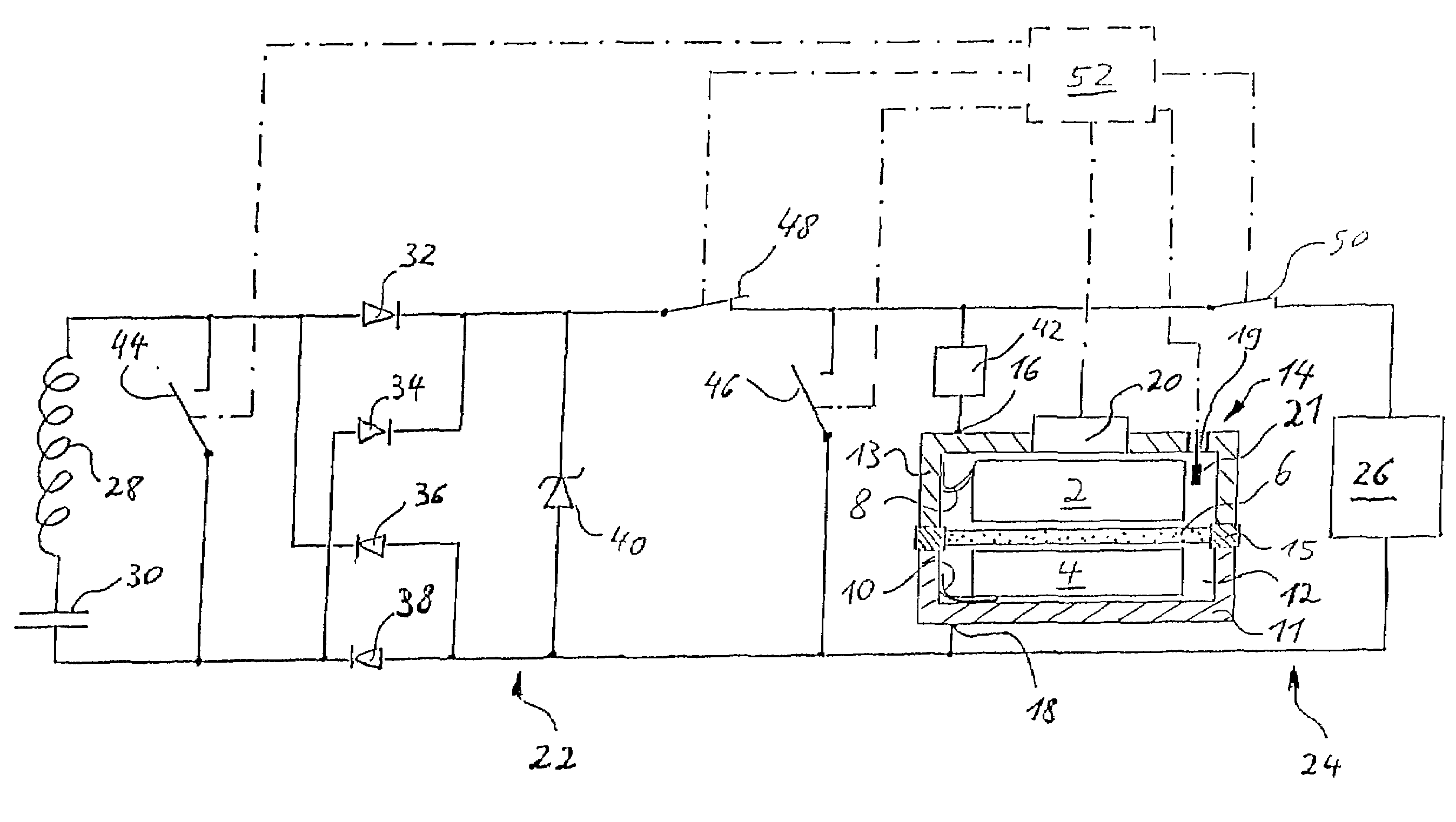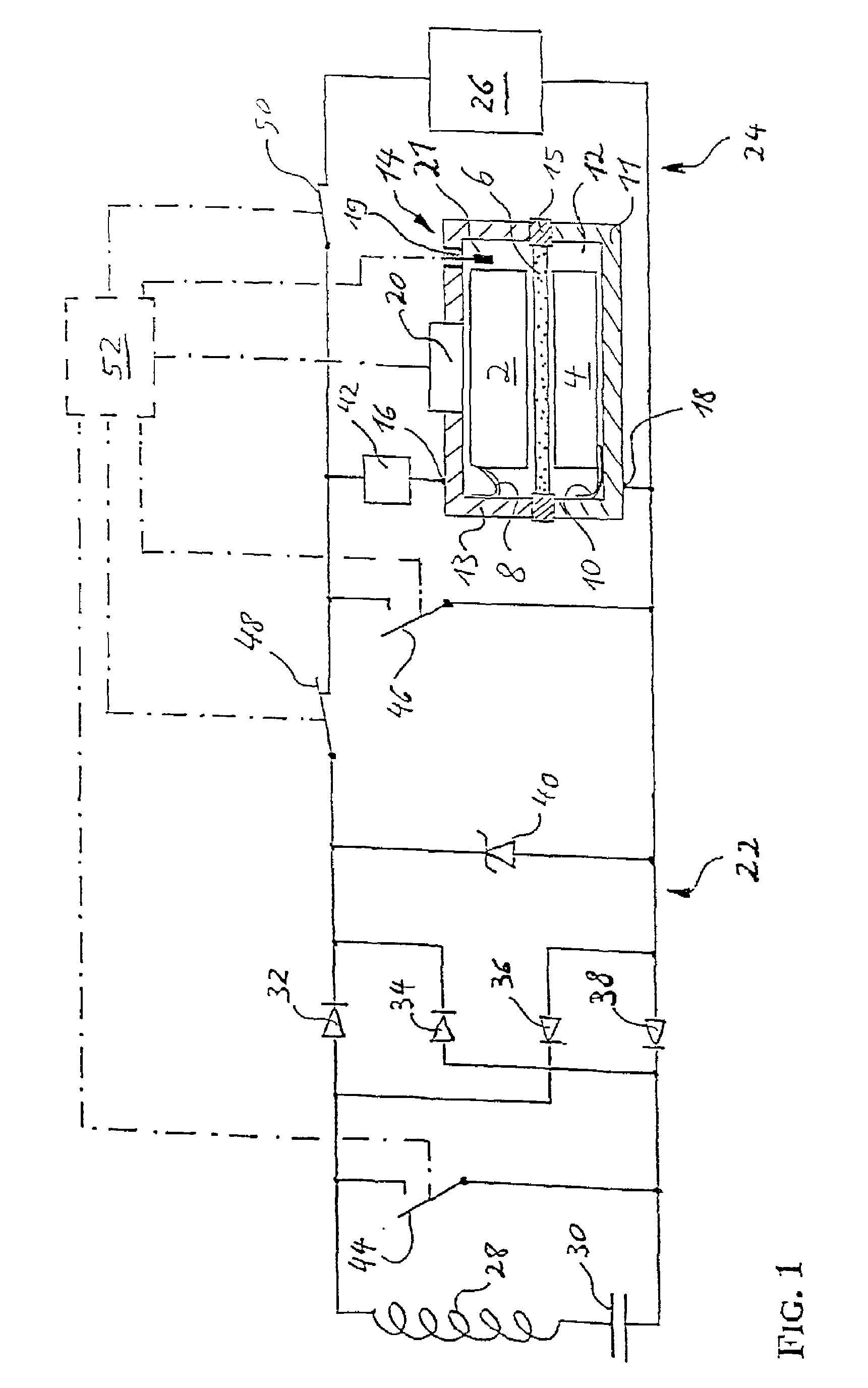Secondary electrochemical cell
a secondary electrochemical cell and electrochemical technology, applied in the field of secondary electrochemical cells, can solve the problems of large reduction of all dimensions, hazard to the implant wearer by malfunction, and contamination of surrounding tissue with toxic substances,
- Summary
- Abstract
- Description
- Claims
- Application Information
AI Technical Summary
Benefits of technology
Problems solved by technology
Method used
Image
Examples
first embodiment
[0067]the secondary electrochemical cell is shown in FIGS. 2 to 4 and includes a hermetically tight protective housing 54 with a cup-shaped cover 56 and a likewise cup-shaped bottom 58. A hollow cylindrical side wall 60 of the cover 56 is welded to a cover plate 62, which, as a bulging membrane, forms the detector element of the secondary electrochemical cell. The bottom 58 is formed by a hollow cylindrical side wall 64 and a bottom plate 66 which is welded to it. The electrodes 2 and 4 of the secondary electrochemical cell are accommodated within the protective housing 54, the positive electrode 2 having a tap which is a contact clip 68 and which makes contact with the inside of the side wall 60. The negative electrode 4 of the secondary electrochemical cell is brought into electrically conductive contact by means of a contact clip 70 as a tap from the inside with the side wall 64, a recess 74 in the edge area of the bottom plate 66 facilitating the installation of the contact clip...
second embodiment
[0075]FIG. 5 shows a secondary electrochemical cell which has a protective housing 116 with a cup-shaped, one-part bottom 118 of electrically conductive material. The protective housing 116 is sealed by a likewise electrically conductive cover 120, between the cover 120 and the bottom 118, an insulating ring 122 of oxide ceramic being soldered in. The insulating ring 122 having an inside diameter which is less than that of the side wall of the bottom 118 bears on its bottom a membrane 138 and on its top a contact membrane 134 electrically insulated against one another. Both membranes 134 and 138 are made of electrically conductive material, the contact membrane 134 with its top being electrically insulated against the adjacent cover 120 by means of an insulating layer 148, and via a metal coating 132, through plating 130 and a solder layer 128 it being connected, in an electrically conductive manner, to the bottom 118. The electrodes 2 and 4, the separator 6 and the electrolyte 12 a...
third embodiment
[0078]According to FIGS. 6 and 7, a secondary electrochemical cell has a protective housing 154 with an electrically conductive bottom which has a side wall 156 in the form of a tube section which is sealed on the face side by a bottom plate 158. A peripherally closed weld 160 joins the bottom plate 158 to the side wall 156. On the second face side of the side wall 156, a solder layer 164 fixes a ceramic insulating ring 162 which has a round opening with an inside diameter which is smaller than the inside diameter of the side wall 156, on the bottom of the insulating ring 162 which points in the direction to the bottom plate 158 a membrane 166 of electrically conductive material, which spans the opening, being attached and a hermetically tight internal space being formed. This internal space holds the positive electrode via the receiver 124 such that electrical contact between the positive electrode 2 and the side wall 156 is precluded and the former is centered at the same time in ...
PUM
| Property | Measurement | Unit |
|---|---|---|
| height | aaaaa | aaaaa |
| height | aaaaa | aaaaa |
| diameter | aaaaa | aaaaa |
Abstract
Description
Claims
Application Information
 Login to View More
Login to View More - R&D
- Intellectual Property
- Life Sciences
- Materials
- Tech Scout
- Unparalleled Data Quality
- Higher Quality Content
- 60% Fewer Hallucinations
Browse by: Latest US Patents, China's latest patents, Technical Efficacy Thesaurus, Application Domain, Technology Topic, Popular Technical Reports.
© 2025 PatSnap. All rights reserved.Legal|Privacy policy|Modern Slavery Act Transparency Statement|Sitemap|About US| Contact US: help@patsnap.com



